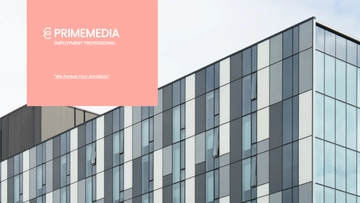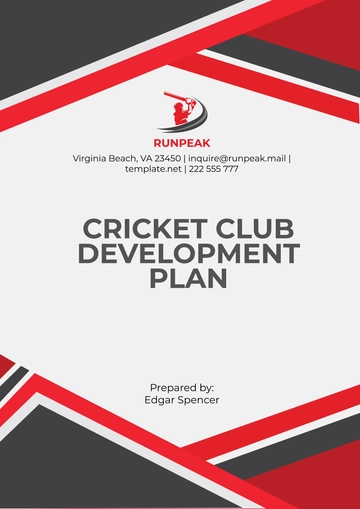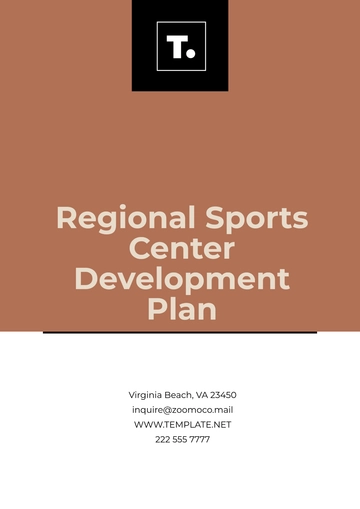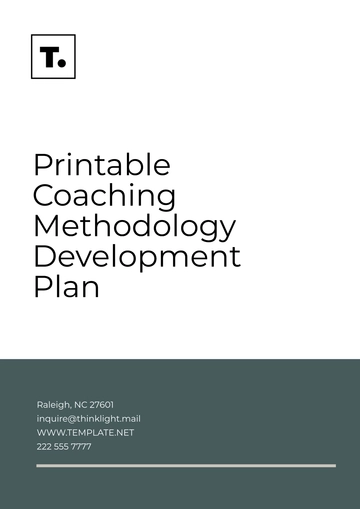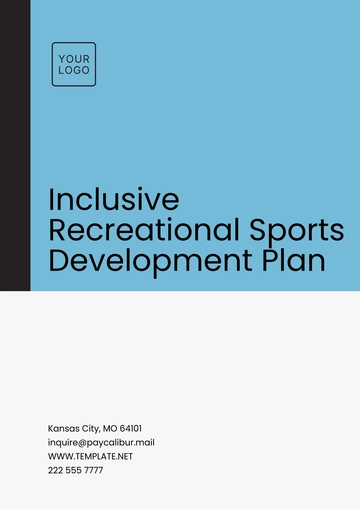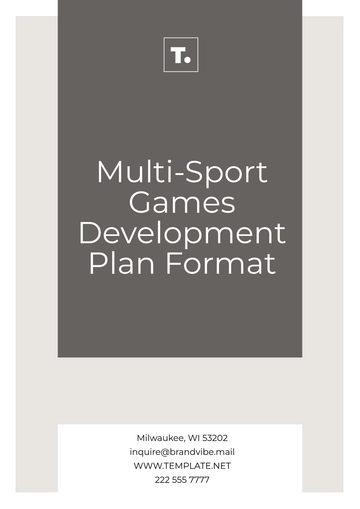Free Sports for Disabled Athletes Development Plan

Prepared by: [Your Name]
Date: June 12, 2050
1. Executive Summary
This development plan aims to enhance the opportunities and facilities available for disabled athletes by improving accessibility, expanding training programs, and fostering an inclusive sports environment. The plan emphasizes collaboration with a wide range of stakeholders, including sports organizations, government bodies, communities, and private sectors. The goal is to create a sustainable, inclusive sports ecosystem that empowers disabled athletes to compete at all levels, from grassroots to professional sports.
2. Introduction
Sports play a pivotal role in improving the physical and mental well-being of individuals with disabilities. However, despite the progress made in many areas, the opportunities and support for disabled athletes remain underdeveloped. This plan outlines a holistic approach to address the gaps in accessibility, coaching, facilities, and funding. By engaging various stakeholders and implementing innovative strategies, this plan aims to create a more equitable and supportive environment for disabled athletes.
3. Background
Globally, the need for dedicated programs and infrastructure for disabled athletes has gained recognition. The development of adaptive sports has become a key focus for promoting inclusivity and enhancing the quality of life for individuals with disabilities. This plan aligns with international standards, ensuring that athletes have access to the resources, facilities, and training they need to reach their full potential. By fostering collaborative partnerships across sectors, we aim to create a supportive sports ecosystem that helps disabled athletes excel in their chosen sports.
4. Goals and Objectives
4.1 Long-Term Goals
Enhance Infrastructure: Develop and maintain accessible sports facilities, including adaptive equipment and accommodations, to support disabled athletes across all levels.
Sustainable Coaching and Support: Establish a comprehensive coaching framework and resources to ensure the professional growth of disabled athletes and their coaches.
Promote Inclusivity: Foster an inclusive culture in all sports, focusing on integration at both the amateur and professional levels.
4.2 Short-Term Objectives
Increase Participation: Increase the participation rate of disabled athletes in local sports events by 30% within the first two years.
Partnerships: Establish collaborations with at least five key organizations dedicated to disabled sports within the first year.
Coaching Development: Offer training workshops for coaches to better support the development of disabled athletes and improve coaching skills specific to adaptive sports.
5. Current Challenges and Opportunities
5.1 Challenges
Limited Access to Facilities: Many existing sports facilities are not adequately equipped for disabled athletes.
Lack of Funding and Sponsorship: Disabled sports programs are often underfunded, with limited corporate or government support.
Awareness Gaps: There is insufficient awareness among the public, coaches, and sports organizations about the specific needs of disabled athletes.
5.2 Opportunities
Public Interest in Adaptive Sports: The growing popularity of the Paralympic Games and other adaptive sports presents an opportunity to increase visibility and participation.
Government and Private Funding: Opportunities exist for government grants and corporate sponsorships aimed at promoting inclusivity and supporting adaptive sports programs.
Technological Advancements: Innovations in adaptive sports equipment and assistive technology offer new opportunities for improving athlete performance and comfort.
6. Strategic Plan
6.1 Infrastructure Development
Investing in the development and renovation of sports facilities is a critical first step in enhancing accessibility for disabled athletes. This will include the installation of adaptive equipment, ramps, wider doorways, and specialized facilities tailored to different disabilities.
Action | Timeline | Responsibility |
|---|---|---|
Conduct an accessibility audit of existing facilities | First 6 months | Facilities Management Team |
Renovate and adapt facilities based on audit results | Year 1 | Local Sports Authority, Contractors |
Introduce adaptive sports equipment in community centers | First-year | Local Sports Authority |
Ensure transport accessibility for athletes with mobility issues | Year 1 | Local Government, Transportation Department |
6.2 Training and Education
Customized training programs will be developed to ensure both coaches and athletes receive the best possible preparation. This includes technical skills, adaptive sports strategies, and athlete well-being. Public awareness campaigns will also be rolled out to promote inclusivity in sports.
Program | Start Date | Target Audience |
|---|---|---|
Coaching Certification Program for Disabled Sports | Month 3 | Sports Coaches, Trainers |
Public Awareness Campaign on Inclusivity | Month 6 | General Public, Schools, Community Organizations |
Athlete Wellness and Support Program | Month 8 | Disabled Athletes and Coaches |
6.3 Funding and Sponsorship
A multi-faceted approach will be adopted to explore funding options. This will include applying for government grants, building relationships with corporate sponsors, and initiating community fundraising programs. Securing long-term partnerships will be a key focus to ensure the sustainability of the programs.
Action | Timeline | Responsibility |
|---|---|---|
Apply for government grants and subsidies | Ongoing | Development Team, Government Relations |
Initiate corporate sponsorship outreach | Year 1 | Sponsorship Manager |
Launch a community-based fundraising initiative | Year 2 | Community Engagement Team |
7. Implementation Timeline
Months | Actions |
|---|---|
1-6 | Conduct needs assessment, start facility audits, begin partner outreach, and initiate accessibility audits. |
7-12 | Launch training programs, initiate funding campaigns, and start facility renovations. |
Year 2 | Expand sports programs, increase event participation, launch inclusion campaigns, and evaluate progress. |
8. Monitoring and Evaluation
Regular evaluation will ensure the development plan remains on track and achieves its objectives. The following monitoring methods will be used:
Key Performance Indicators (KPIs): Set benchmarks for participation rates, facility improvements, and athlete performance.
Bi-annual Reviews: Conduct comprehensive reviews every six months to assess the effectiveness of programs and identify areas for improvement.
Stakeholder Feedback: Gather feedback from athletes, coaches, and stakeholders to adjust programs and ensure they meet the evolving needs of disabled athletes.
Annual Reporting: Produce an annual report detailing progress, challenges, and outcomes, which will be shared with all stakeholders.
9. Risk Management
Identifying potential risks and preparing strategies to mitigate them is essential for the success of this development plan. Risks include:
Insufficient Funding: Strategies to mitigate this risk include diversifying funding sources and prioritizing cost-effective solutions.
Lack of Stakeholder Engagement: Engage stakeholders early in the process, ensuring their active participation through regular communication and involvement in decision-making.
Delays in Infrastructure Development: Carefully manage timelines and allocate sufficient resources to minimize delays in facility adaptations and improvements.
10. Conclusion
This development plan lays the foundation for creating a more inclusive sports environment for disabled athletes. Through strategic investments in infrastructure, training, funding, and community outreach, the plan aims to overcome existing barriers and provide disabled athletes with the opportunities and support they need to thrive. By working together with all stakeholders, we can create a sustainable, inclusive sports ecosystem that benefits everyone.
- 100% Customizable, free editor
- Access 1 Million+ Templates, photo’s & graphics
- Download or share as a template
- Click and replace photos, graphics, text, backgrounds
- Resize, crop, AI write & more
- Access advanced editor
The Sports for Disabled Athletes Development Plan Template from Template.net is fully customizable and editable to meet your specific needs. Create a tailored development plan with ease, utilizing our intuitive Ai Editor Tool for effortless editing. This template helps organizations design effective programs to support disabled athletes’ growth and performance, all in one convenient package.

